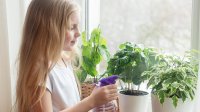10 Best Plants for the Classroom
Plants do more than liven up your decor—they can help students feel better, and learn better too.
Your content has been saved!
Go to My Saved Content.With student stress on the rise, teachers are trying all sorts of things to put students at ease—outdoor walks, mindfulness activities, even allowing fidgets. Class plants are worth adding to this list.
Greenery has been shown to reduce student stress and enhance attention levels. Plants also shift students’ perceptions. In one study, university students taking the same course with the same professor were broken into two sections: one in a classroom with plants and one without plants. Students in the classroom with plants rated the course and instructor as significantly better.
A few plants can transform a classroom’s atmosphere, providing a connection to nature for students who don’t love the outdoors. “Outside, students complain about heat, rain, bugs, mud,” explains special education teacher Regina Hawkings. “Having plants in the classroom is not as overstimulating.”
Admittedly, most classrooms are not exactly greenhouses. They tend to be dry, with more indirect light than sunshine. But there are plants that can survive and even thrive in these conditions.
3 Reliably Lush Plants
Even when a teacher has absolutely no time for plant care, these stalwarts still have a good chance of long life.
The ZZ plant’s other name—cast iron plant—suggests its durability. Ruth Williams, a home economics teacher, loves its ruggedness: ZZ (short for Zamioculcas zamiifolia) plants “are really, truly hard to kill. I only bring plants into my classroom that can survive two weeks of winter break or spring break. My ZZ plants can go the whole summer without care!” Williams encourages students to bond with the classroom plants by naming them.
Snake plant (Dracaena), also known as mother-in-law’s tongue, is not a single plant but a group of species. These plants are survivors and can withstand abuse. Their leathery, patterned leaves sometimes have a single barb at the tip that can easily be snipped off with scissors.
Pothos (Epipremnum aureumare) grows quickly and soon becomes a decorative vine. The Florida nonprofit A Plant in Every Classroom uses pothos as its flagship plant to donate to schools. As founder Kerry Schabacker explains, “Pothos is a great choice since it is low light, low allergy, low toxicity, and low watering—just once a week. A lot of the classrooms have air-conditioning units or the windows blocked so the students can see the teaching screen. Pothos does well in these conditions.”
Schabacker has witnessed students form emotional bonds with their plants. “There was a child who would pet the pothos each day to make himself feel better. In one class, the students liked the plant so much, the teacher got four more.”
3 Charismatic Succulents
In a sense, this group of plants enjoys neglect. The same waxy cuticle that insulates them from the sun also protects them from drying out indoors. Water once a week at most and be sure there is good drainage. A dish at the bottom where the extra water can run out works best, so your succulent isn’t sitting in a puddle.
Aloe is a lovely first plant for any classroom. It prefers bright light, but too much sunshine will turn the leaves brown. Students love aloe “pups”—the small clones that pop up around the mother plant over time. One of my most popular lessons challenges students to perform “surgery” to separate and then repot the pups.
Elephant bush (Portulacaria afra) reaches heights of 15 feet in Africa, where it’s a favorite pachyderm food. Indoors, however, it’s small and can live in tiny pots. Think of it as a tougher, leggier, faster-growing jade plant, and consider perching it on a window ledge.
Kalanchoe (Kalanchoe blossfeldiana) is the plant that blooms the most on this list. It produces big umbrellas of flowers in red, pink, yellow, or white. A native of Madagascar, it needs a bright window and, ideally, a bit of sun.
4 That Are a Little Different
If you have a bit more time to spare—15 minutes a week—these plants bring extra panache to a classroom.
Blue Star fern (Phlebodium aureum), like all ferns, wants to stay damp. It’s not a plant that can be abandoned over summer. In addition, it’s an epiphyte, meaning that in the wild its shiny, deep green fronds and curious, furry runners can be found growing on tree branches.
Scented geranium (Pelargonium scabrum) graces anyone who touches it with a light, perfumy scent such as (depending on the variety) lemon, rose, eucalyptus, peach, or apple. It can be brought home and planted outdoors in summer.
Norfolk Island pine (Araucaria heterophylla) is a common houseplant not often seen in schools. It likes sun but can tolerate shade, and its gentle needles are endlessly touchable. The fluffy soil it prefers is surprisingly light, which means that students will knock over Norfolk pines unintentionally, so put it in a heavy pot or weigh the container down with a layer of gravel in the bottom.
Microgreens aren’t a plant but a raft of baby plants. They require more equipment (a heating mat and sometimes a grow light) but less commitment than an ornamental. Students can eat them. “Microgreens are a good place for educators to start because they are harvested quickly and can be grown in very low light,” according to Sarah Pounders of the nonprofit organization KidsGardening.
A Note on Ingestion and Allergies
Many ornamental plants can sicken people if ingested. If your students might nibble a classroom plant, look up its toxicity using the scientific name before buying. Most classroom plants seldom flower, and that keeps pollen from irritating allergies. Waterlogged soil presents a greater threat because of its potential for mold.
With minimal care, plants can provide myriad benefits to both classrooms and students’ lives.
